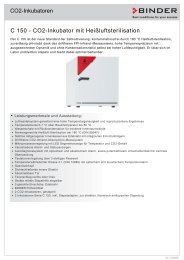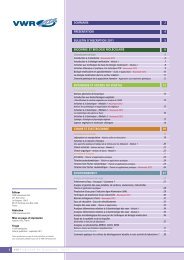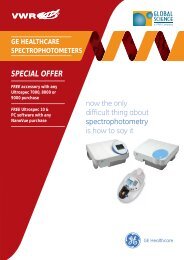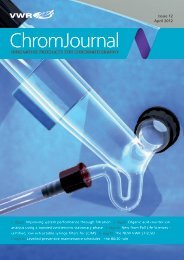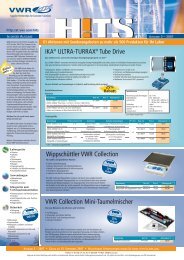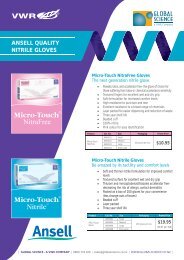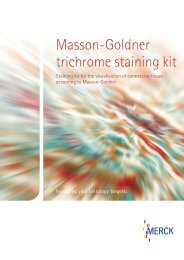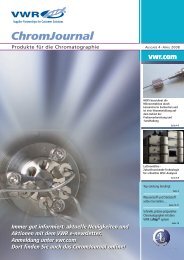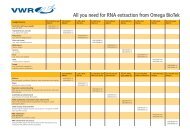CEll bIOlOGy
CEll bIOlOGy
CEll bIOlOGy
You also want an ePaper? Increase the reach of your titles
YUMPU automatically turns print PDFs into web optimized ePapers that Google loves.
genomics<br />
For more information on these products contact your local VWR sales office,<br />
send an e-mail to vwrbiomarke@eu.vwr.com or visit our website www.vwr.com<br />
Green I has been suggested to interfere<br />
with DNA repair mechanisms in cells and<br />
as a result it potentiates the genotoxicity<br />
of other mutagens as well as DNA<br />
damage by UV light. Although no safety<br />
data is available on other PCR and HRM<br />
dyes (e.g., SYTO9, LC Green, BRYT Green<br />
and ResoLight), these dyes are known<br />
to be cell membrane permeable, thus<br />
posing potential genotoxicity risk. With<br />
this in mind, Biotium’s scientists designed<br />
EvaGreen ® dye to be cell membrane<br />
impermeable by increasing the molecular<br />
size and charge of the dye (Figure 3).<br />
Because EvaGreen ® dye is denied the<br />
chance to interact with genomic DNA<br />
in living cells, it is much safer than other<br />
qPCR dyes. Independent laboratory<br />
testing has confirmed that EvaGreen ® is<br />
non mutagenic, non cytotoxic and safe to<br />
aquatic life. The dye meets environmental<br />
hazardous waste regulations in the<br />
state of California (CCR title 22) for easy<br />
disposal down the drain. Visit Biotium’s<br />
website to download the full EvaGreen ®<br />
dye safety report.<br />
Dye stability<br />
EvaGreen ® dye is highly stable during<br />
storage and PCR. SYBR ® Green I, on<br />
the other hand, is known to degrade<br />
following multiple freeze-thaw cycles<br />
and under PCR conditions. Moreover,<br />
decomposed SYBR ® Green I is reported to<br />
be even more inhibitory to PCR than the<br />
intact dye.7 As a result, when assessing<br />
the performance of EvaGreen ® master<br />
mix, you can eliminate the stability of the<br />
dye as a variable.<br />
Spectral compatibility<br />
EvaGreen ® dye is spectrally similar to<br />
FAM or SYBR ® Green I. No change in<br />
optical settings is required when using an<br />
EvaGreen-based master mix (Figure 4).<br />
Figure 4. Excitation and emission spectra<br />
of EvaGreen in the presence of dsDNA<br />
Other applications<br />
EvaGreen ® dye has been applied in<br />
numerous other applications, such as<br />
isothermal amplification, capillary gel<br />
electrophoresis, DNA quantitation in<br />
solution and selective staining of dead<br />
cells in cell viability tests.<br />
Biotium offers several EvaGreen ® dyebased<br />
products, including stand-alone<br />
EvaGreen dye and EvaGreen ® dye master<br />
mix products. Biotium’s EvaGreen ® dye<br />
technologies are available for licensing.<br />
References:<br />
1. Khan, et al. Detection of aacA-aphD, qacE 1, marA,<br />
floR, and tetA genes from multidrug-resistant<br />
bacteria: comparative analysis of real-time multiplex<br />
PCR assays using EvaGreen ® and SYBR ® Green I<br />
dyes, Molecular and Cellular Probes (2011), doi:<br />
10.1016/j.mcp.2011.01.004.<br />
2. Cheng, et al. Detection of hemi/homozygotes<br />
through heteroduplex formation in high-resolution<br />
melting analysis, Anal. Biochem. 410, 158 (2011).<br />
3. White, et al. Methylation-sensitive high-resolution<br />
melt-curve analysis of the SNRPN gene as a<br />
diagnostic screen for Prader-Willi and Angelman<br />
Syndromes. Clin. Chem. 53, 1960 (2007).<br />
4. Mao, et al. Characterization of EvaGreen Dye and<br />
the implication of its physicochemical properties for<br />
qPCR applications. BMC Biotechnology 7, 76 (2007).<br />
5. Giglio S, et al. Demonstration of preferential binding<br />
of SYBR Green I to specific DNA fragments in realtime<br />
multiplex PCR. Nucleic Acids Res. 31(22), e136<br />
(2003).<br />
6. Ohta, et al. Ethidium bromide and SYBR Green I<br />
enhances the genotoxicity of UV-irradiation and<br />
chemical mutagens in E. coli, Mut. Res. 492, 91<br />
(2001).<br />
7. Karsai, et al. Evaluation of a homemade SYBR green<br />
I reaction mixture for real-time PCR quantification of<br />
gene expression. BioTechniques 32(4), 790 (2002).<br />
* Practicing HRM may require a license from Idaho<br />
Technologies, Inc.; SYBR, ResoLight, LC Green and<br />
BRYT Green are trademarks of Invitrogen, Roche,<br />
Idaho Technologies and Promega, respectively;<br />
EvaGreen technologies are covered by US patent<br />
numbers 7,601,498, 7,776,567 and other pending<br />
US and international patents.<br />
Figure 3. Comparison of cell membrane<br />
permeability between EvaGreen ® dye and<br />
SYBR ® Green I. HeLa cells were incubated<br />
with SYBR ® Green I (1,2 uM) or EvaGreen ®<br />
dye (1,2 uM) at 37 °C. Photographs were<br />
taken following incubation for 5 and<br />
30 minutes. SYBR ® Green I entered cells<br />
rapidly while EvaGreen ® dye appeared<br />
membrane impermeable as evident from<br />
the absence of cell nuclear staining.<br />
Image taken with long photo exposure<br />
time revealed that EvaGreen ® dye only<br />
associated with cell membranes.<br />
Description Size Cat. No.<br />
EvaGreen ® dye, 20x in water<br />
1 ml trial size BTIU31000-T<br />
5x 1 ml<br />
BTIU31000<br />
100 rxn trial size BTIU31020-T<br />
Fast-Plus EvaGreen ® Master mix (no ROX)<br />
200 rxn BTIU31020<br />
500 rxn BTIU31020-1<br />
5000 rxn BTIU31020-2<br />
100 rxn trial size BTIU31014-T<br />
Fast-Plus EvaGreen ® Master mix with low ROX<br />
200 rxn BTIU31014<br />
500 rxn BTIU31014-1<br />
5000 rxn BTIU31014-2<br />
100 rxn trial size BTIU31015-T<br />
Fast-Plus EvaGreen ® Master mix with high ROX<br />
200 rxn BTIU31015<br />
500 rxn BTIU31015-1<br />
5000 rxn BTIU31015-2<br />
VWR International I VWRbioMarke Issue 27 I September 2011 I<br />
15



